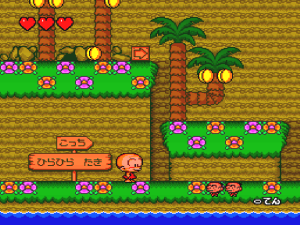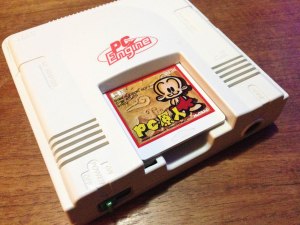After the Famicom, The MSX personal computer was the next biggest player in Japanese gaming in the the 8-bit era, followed by Sega’s SG1000/Mark III series.
Sega had to settle for third place again in the next round, thanks to another type of PC: NEC’s PC Engine console.

The PC Engine was a collaboration between software developer Hudson Soft and computer manufacturer NEC. Released in 1987, the timing of the PC Engine’s release fit perfectly in a lull in the market, between the dominant but ageing Famicom, and the long awaited release of the Super Famicom. I believe was the highest selling console in either 1988 or 1989.
Keen Japanese gamers jumped at the opportunity to own a more powerful gaming box, and partly due to a smart hardware design that could draw lots of sprites with no hiccups, right from the start the PC Engine thrived on ‘hardcore’ arcade genres like shooters and other action games.

Partly because of this arcade focus, the PC Engine was also able to maintain a market position even after the release and eventual domination of the Super Famicom. While Nintendo and other industry leaders like Squaresoft and Enix were pulling the industry away from its arcade roots with longer-form games like RPGs and adventures (Zelda, Metroid, Dragon Quest – even Mario had save features and became more of an exploring game than one you defeated in a single sitting), there was a place for a console which was a haven for games of the old paradigm.
As co-creator, Hudson produced many of the key titles, including mascot titles like PC Genjin, and shooters like the Star Soldier series. But the console had relatively wide third party support, and many of the defining titles were high quality arcade ports from third parties.
The PC Engine was also the first ever system to have a CD attachment released, which attracted PC developers and ambitious multi-media projects from console developers. This was yet another point of differentiation from Nintendo’s machine. CD players were expensive at the time, and so the price required to join the CD party locked the platform into its already established hardcore niche.

A notable feature of the PC Engine is how tiny the pre-CD console is. The original release is dwarfed in size by the contemporary consoles. It’s a really nice piece of engineering.
One of the reasons the console can be so small is that the games came on credit-card sized ‘Hu-Cards’ and fit in a front-loading slot.
Hu-cards are pretty much a straight copy of Sega’s SG1000 and Mark III ‘My Card’ format. They even came in the same type of vinyl sleeve inside the packaging, though thankfully PCE games also came in a CD case sized plastic case, instead of Sega’s cardboard boxes.
The original PC Engine only had an RF connection in the box, but the console included a huge external out connector, allowing peripherals access to many system functions and chip outputs, including composite, RGB and audio out pins. A peripheral known as the ‘AV Booster’ was released allowing composite outputs, and it’s even relatively easy to make your own simple composite cable that connects to the correct four pins:

PC Engine, being an 80s Japanese console, also has very short controller cords. But luckily the controller used a standard 8-pin mini-din plug (commonly used to connect Apple Macintosh computers in the 80s and 90s) so you can grab an extension cable much more easily and cheaply than for other consoles. It did however only have one controller port, meaning a multi-tap is required even for two player games.
Partly due to the success of the CD add-on, it’s also the console with possibly the most versions ever released. There were several versions of the original console released (one each from NEC and Hudson adding native composite output), a couple of different CD interface units to add a CD drive to these consoles, along with several generations of ‘system cards’ which contained software and RAM upgrades for the CD system’s use. There was also a weird semi-upgrade called the SuperGrafix, and finally several units combining the PCE, CD unit, and system cards.
This is the final version, the PC Engine Duo RX.

While the original console was famous for being small, the final PC Engine release is quite large, dwarfing the original unit.
So that’s the PC Engine. In a lot of ways it’s appealing as the ‘last gasp’ for the idea of a home console bringing the arcade experience home, with its many great arcade style action games.

At the same time, it was simultaneously a glimpse at the future, with its successful CD implementation.
The appeal of the PC Engine matches up well with the wants of many dedicated gamers, and as a result it remains an expensive console to collect for.














I really like this article, the PC Engine is one of my all time favourite consoles, it was the first console I spent a lot of time with. Just a couple of things, Ninja Spirit was originally an arcade game by Item ported to the PC Engine: https://www.youtube.com/watch?v=qekvX9HYiL0.
Also the SuperGrafx was supposed to be a PC Engine 2 really, an upgraded version, but it never took off. I never understood why it was so big but it’s kind of cool, I’d like one and Ghouls N Ghosts is a good conversion on it.
LikeLike
Hi Paul,
Thanks for that, Ninja Spirit caption fixed.
I’d say the SuperGrafx was a half-hearted ‘PC Engine 2’ at best though, and with only five exclusive titles released it’s just a footnote really. NEC certainly went on as if it never happened quite quickly 😉
LikeLike
I recently purchased a japanese PC Engine with an AV Booster. So now I’m looking for the best way to hook it up to a PAL television. Is it compatible with the MTV-Box you talked about in an other article or do you have any other suggestions?
LikeLike
Hi, it should just be able to plug into your TV with the AV booster. I’d recommend looking into RGB output however.
LikeLike